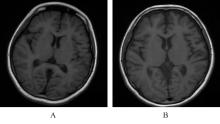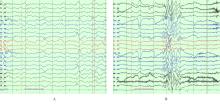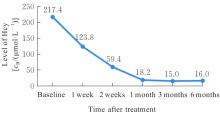| [1] |
Yang LIU,Zhi LIU,Ke SUN,Jiahui JIN,Jun REN.
Anti-LGI-1 positive autoimmune encephalitis complicated with sleep structure abnormality and cognitive impairment: A case report and literature review
[J]. Journal of Jilin University(Medicine Edition), 2024, 50(4): 1137-1143.
|
| [2] |
Jing TANG,Huan LI,Shuo ZHANG,Ligang JING.
Analysis on association between serum homocysteine and inflammatory response and oxidative stress in patients with acute ischemic stroke
[J]. Journal of Jilin University(Medicine Edition), 2024, 50(3): 786-790.
|
| [3] |
Zhongyan ZHAO,Zhiyu XU,Chanji WU,Eryi ZHAO,Dan HUANG,Shixiong HUANG.
Autoimmune encephalitis with double positive anti-NMDAR and anti-GABABR secondary to herpes simplex virus encephalitis: A case report and literature review
[J]. Journal of Jilin University(Medicine Edition), 2024, 50(1): 236-242.
|
| [4] |
Hang SU,Jia LI,Huibin ZENG,Jiajun CHEN.
Autoimmune encephalitis with positive anti-GAD65 and anti-GABABR double antibodies:One case report and literature review
[J]. Journal of Jilin University(Medicine Edition), 2023, 49(6): 1604-1609.
|
| [5] |
Xingguo ZHANG,Chenguang LI,Zhili ZHANG,Yu SUN,Wei CUI,Qiu CHU,Fengjuan QIAO,Yubing WANG,Bingxin SUN.
Epidemiological characteristics of patients with hand-foot-mouth disease in Changchun City of Jilin Province and genetic characteristics of enterovirus 71 VP1
[J]. Journal of Jilin University(Medicine Edition), 2022, 48(1): 234-240.
|
| [6] |
Zheng GUI,Jingfeng YU,Lan MU.
Detection of DNA in spotted fever group Rickettsia carried by Dermacentor nuttalli in partial areas of Inner Mongolia and its distribution of genotypes
[J]. Journal of Jilin University(Medicine Edition), 2021, 47(1): 210-215.
|
| [7] |
Yulei WEI,Yuhuan CUI,Bo HAN,Dawei WANG,Guigang WANG,Qian LI,Wen ZENG.
Clinical effect of valve replacement combined with radiofrequency ablation and left atrial appendage closure in treatment of valvular heart disease complicated with atrial fibrillation
[J]. Journal of Jilin University(Medicine Edition), 2020, 46(6): 1298-1303.
|
| [8] |
DU Na, MAO Xijing, YU Tingmin, YAO Gang.
Clinical manifestations and early combined diagnosis of subacute combined degeneration of spinal cord:A report of 18 cases
[J]. Journal of Jilin University Medicine Edition, 2018, 44(04): 806-809.
|
| [9] |
XING Shaoji, ZHENG Liansheng, WANG Diandong, ZHANG Xuan, CHI Min.
Analysis on association between single nucleotide polymorphism of selenoprotein S gene and risk of liver cancer
[J]. Journal of Jilin University Medicine Edition, 2018, 44(03): 558-562.
|
| [10] |
WANG Mingrui, ZHAI Xiuyu, WANG Gang, ZHANG Wenlan, GAO Baoshan, ZHOU Honglan, FU Yaowen.
Effects of CYP3A5 genetic polymorphisms on metabolism of tacrolimus in patients after kidney transplantation
[J]. Journal of Jilin University Medicine Edition, 2018, 44(03): 537-542.
|
| [11] |
DONG Zefeng, ZHENG Tianli, FAN Xuejia, Pei Xiaofang.
Epidemic characteristics of rhinovirus in hospitalized children with respiratory syndrome in Chengdu during 2011-2013
[J]. Journal of Jilin University Medicine Edition, 2016, 42(01): 177-181.
|
| [12] |
YU Xiuyan, WANG Wenlong, WU Xuefeng, LIU Xiaofeng.
Detection of serum folate, homocysteine and vitamin B12 in patients with non-smallcell lung cancer and its clinical significance
[J]. Journal of Jilin University Medicine Edition, 2015, 41(06): 1235-1238.
|
| [13] |
LIU Yang, CHEN Kelin, LI Xiangyan, LI Qing, LI Jinghua.
Detection of human papillomavirus DNA genotypes in different populations and its clinical significance
[J]. Journal of Jilin University Medicine Edition, 2015, 41(06): 1211-1214.
|
| [14] |
ZHANG Yan, CUI Wei, WEN Yan, WANG Qing.
Assay of levels of serum cystatin C and homocysteine in patients with type 2 diabetic nephropathy and their clinical significances
[J]. Journal of Jilin University Medicine Edition, 2015, 41(05): 998-1003.
|
| [15] |
FU Qianxi, ZHOU Li, TANG Min, ZHANG Mingjun, TANG Xiaojun.
Analysis on association between polymorphism of apolipoprotein E genotypes and blood lipid levels in male population
[J]. Journal of Jilin University Medicine Edition, 2015, 41(04): 808-813.
|
 ),Ran ZHOU,Xinying ZHANG,Yaying CHENG
),Ran ZHOU,Xinying ZHANG,Yaying CHENG









